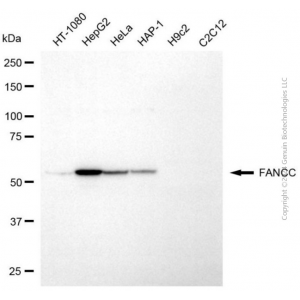| Reactivity: | Human |
| Applications: | WB |
| Host Species: | Mouse |
| Isotype: | IgG1 |
| Clonality: | Monoclonal antibody |
| Gene Name: | FA complementation group C |
| Gene Symbol: | FANCC |
| Synonyms: | FA3; FAC; FACC |
| Gene ID: | 2176 |
| UniProt ID: | Q00597 |
| Clone ID: | 24GB8340 |
| Immunogen: | Recombinant protein of human FANCC |
| Dilution: | WB 1:500-1:2,500 |
| Purification Method: | Affinity purified |
| Concentration: | Lot dependent |
| Buffer: | PBS with 0.09% Sodium azide, 50% glycerol, pH7.3. |
| Storage: | Store at -20°C. Avoid freeze/thaw cycles. |
Background
The Fanconi anemia complementation group (FANC) currently includes FANCA, FANCB, FANCC, FANCD1 (also called BRCA2), FANCD2, FANCE, FANCF, FANCG, FANCI, FANCJ (also called BRIP1), FANCL, FANCM and FANCN (also called PALB2). The previously defined group FANCH is the same as FANCA. Fanconi anemia is a genetically heterogeneous recessive disorder characterized by cytogenetic instability, hypersensitivity to DNA crosslinking agents, increased chromosomal breakage, and defective DNA repair. The members of the Fanconi anemia complementation group do not share sequence similarity; they are related by their assembly into a common nuclear protein complex. This gene encodes the protein for complementation group C.
Images
 | Western blotting analysis using anti-FANCC antibody (Cat#63882). Total cell lysates (30 μg) from various cell lines were loaded and separated by SDS-PAGE. The blot was incubated with anti-FANCC antibody (Cat#63882, 1:2,500) and HRP-conjugated goat anti-mouse secondary antibody (Cat#101, 1:20,000) respectively. Image was developed using FeQ™ ECL Substrate Kit (Cat#226). |
 | Western blotting analysis using anti-FANCC antibody (Cat#63882). FANCC expression in wild type (WT) and FANCC shRNA knockdown (KD) HeLa cells with 20 μg of total cell lysates. Hsp90 α serves as a loading control. The blot was incubated with anti-FANCC antibody (Cat#63882, 1:2,500) and HRP-conjugated goat anti-mouse secondary antibody (Cat#101, 1:20,000) respectively. Image was developed using FeQ™ ECL Substrate Kit (Cat#226). |
You may also be interested in:

